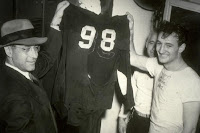“State of” in the sense that Michigan is a state, and in the sense of a condition of being. Part 1: How does Ohio State continue to keep all of the best in-state talent for themselves, while Michigan players go to other schools, including USC and Michigan State?
Statewide Pipeline
The primary reason that Ohio State manages to keep all the best Ohio talent for itself is a lack of instate competition. Until Cincinnati moved to the Big East in 2005, OSU was the only BCS school in the state, and until the Big East (and Cincinnati under Brian Kelly) becomes more respected as a big-time conference (and legitimate major school), Ohio State will continue to reign supreme over its home turf. Perhaps coincidentally (or maybe not), the majority of teams in the state also share one important thing with the Buckeyes: the color red. Cincinnati, and Miami among Division I schools, and pro teams including the Cincinnati Reds and Cleveland Indians and Cavaliers have red as one of their colors. For comparison, Michigan has two main colors, which fans in their own stadium can’t even coordinate (and the pro teams share none of, unless you count the Pistons’ blue as being close enough to Michigan’s).
In Michigan, there are two BCS-level schools, both of whom compete in the Big Ten conference. While Michigan State is seen as more of a rival for non-revenue sports to Michigan fans (they concede basketball to the Spartans in exchange for football dominance), Spartan fans see the football rivalry as very real. Individuals who have been in the state for a long time can easily remember when MSU football was the big game in town (before Canham and Schembechler returned Michigan to Glory – and not in the LOL ND way). Overall, there is a near 50-50 split between Wolverine and Spartan fans in the Great Lakes State.
While having two popular schools in the state may not explain why talent is willing to leave entirely (and go to USC, for example), it certainly helps explain why there is no allegiance to a particular school. With no ties to UofM, Michigan’s players don’t feel obligated to give Michigan more of a shot. This is not the case in Ohio, where nearly every baby’s first outfit is either scarlet or gray.
In Michigan, the allegiance is not to one college team, but to one pro city, Detroit. The state throws itself behind the Tigers, Red Wings, Pistons, and (for some reason) Lions, then divides its attention between MSU and Michigan, and to a lesser extent the other state schools. I still remember the 2006 MSU game, where the score of the simultaneous Tigers game against the Yankees was announced, and Chad Henne had to take a timeout, because fans were cheering more for the Tigers (while the team that they actually paid money to see was on offense) than I have ever heard them cheer for Michigan. Ohio on the other hand, is a state united by one college team, Ohio State, and divided among several pro cities (Cincinnati, Cleveland, and Columbus). This factor also gives the Buckeyes an in-state advantage.
It isn’t likely that UCincinnati ever becomes as ingrained into Ohio culture like the Buckeyes are, and Michigan State, while always little brother, isn’t going to go away any time soon. In-state, Michigan will always be disadvantaged in the Mitten compared to Ohio in the… uh… heart-shaped thing.
Posted under Analysis


